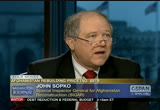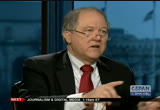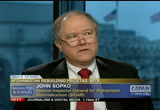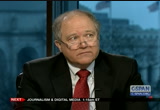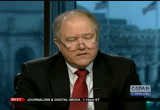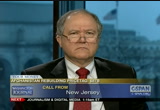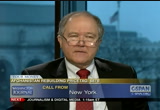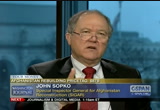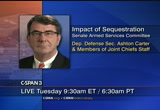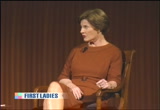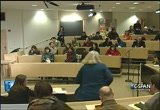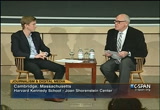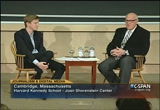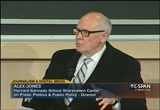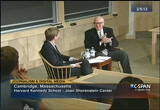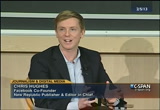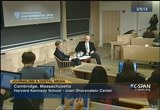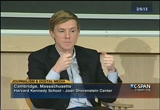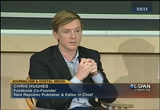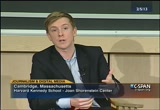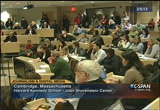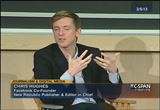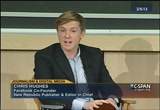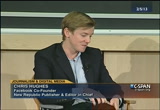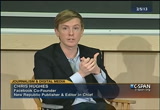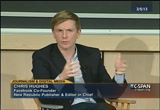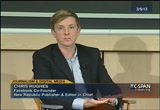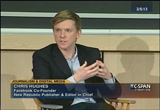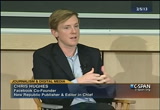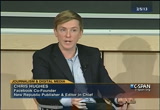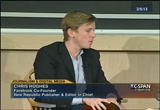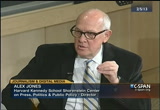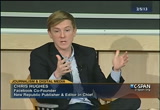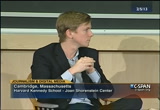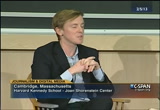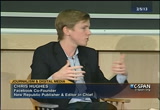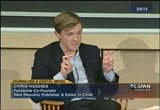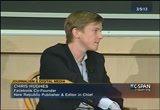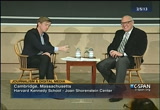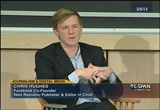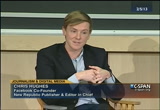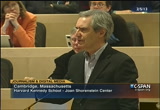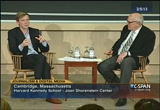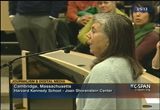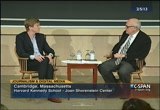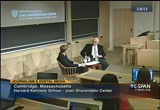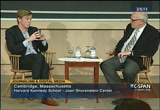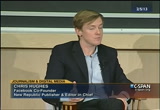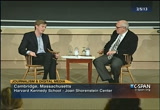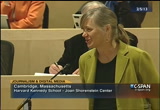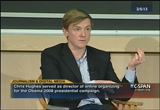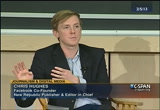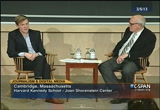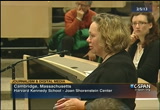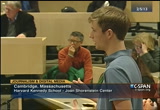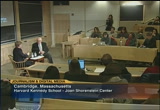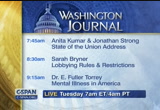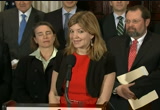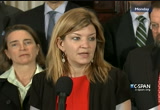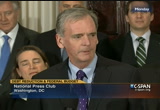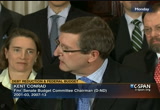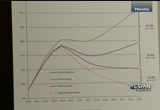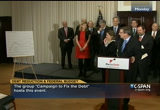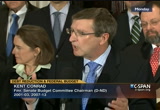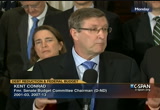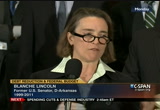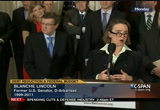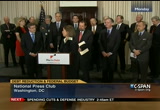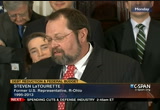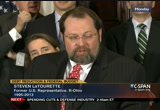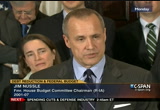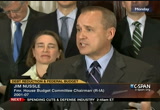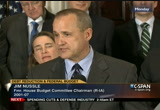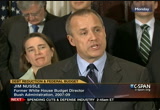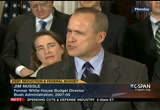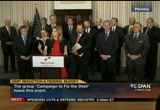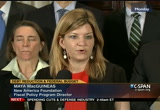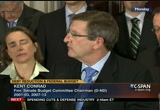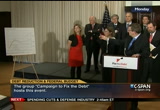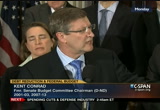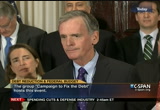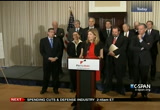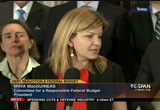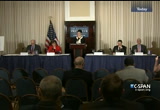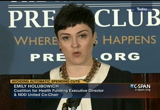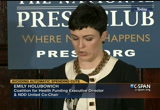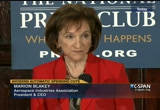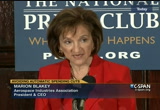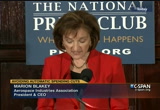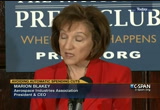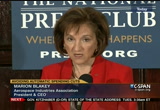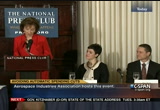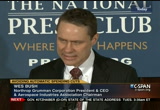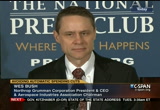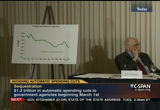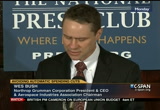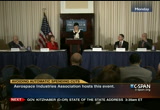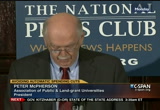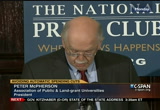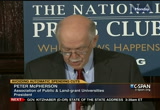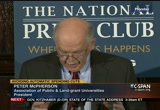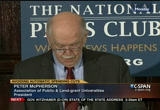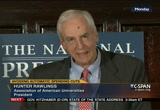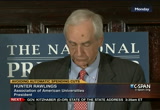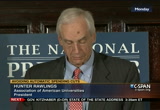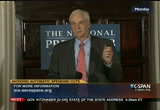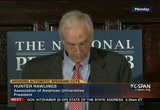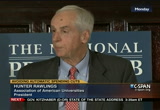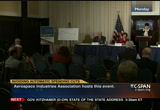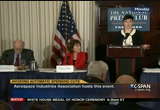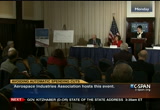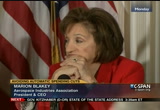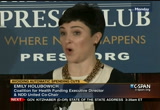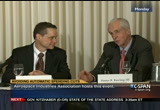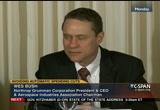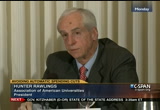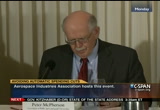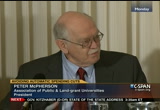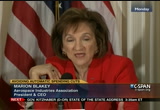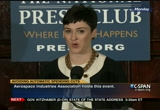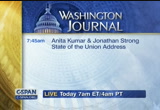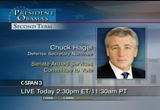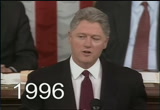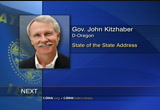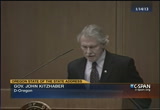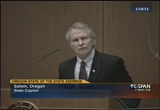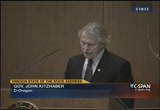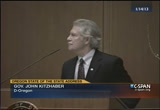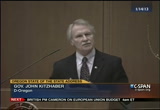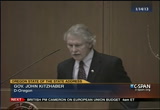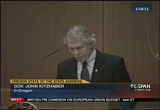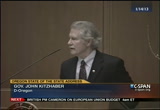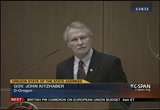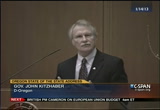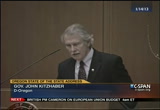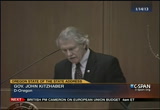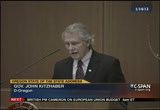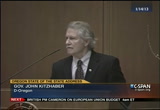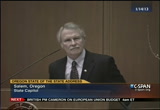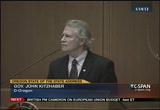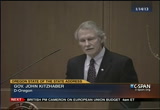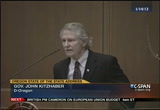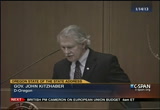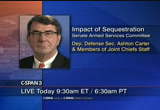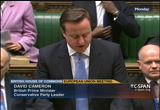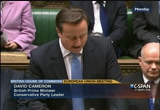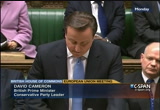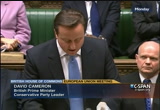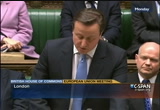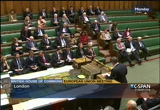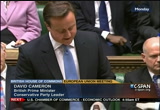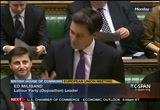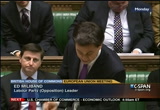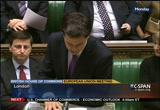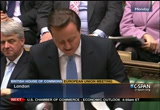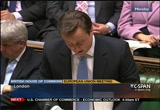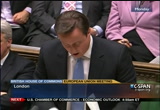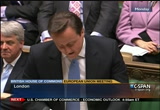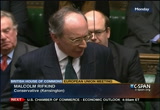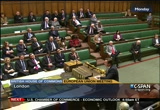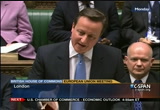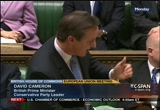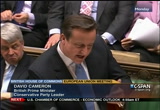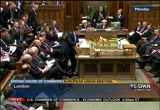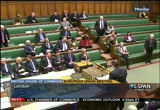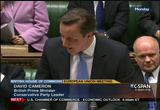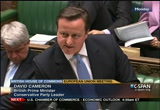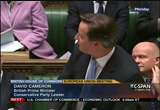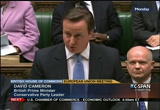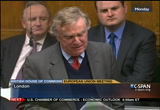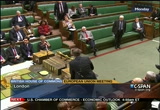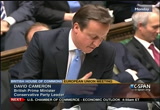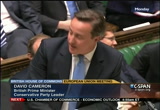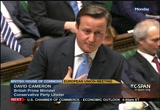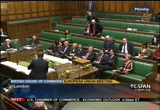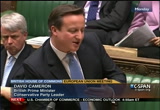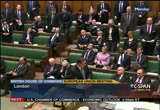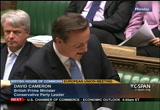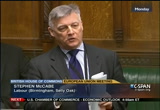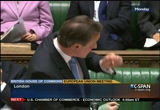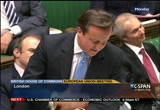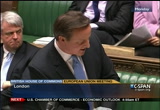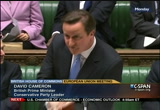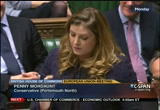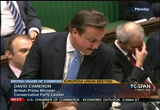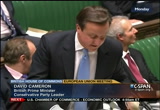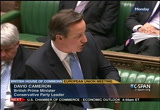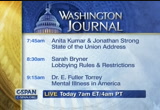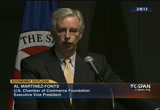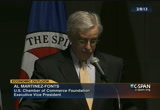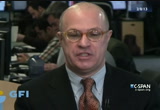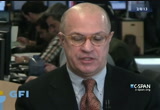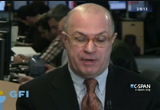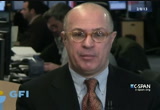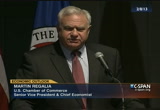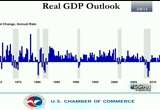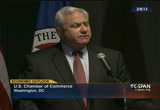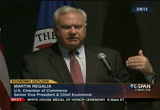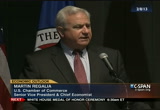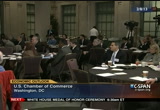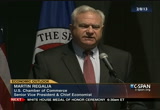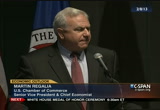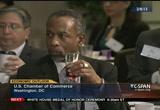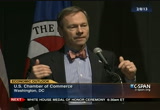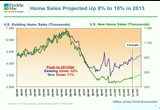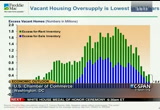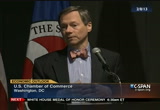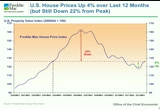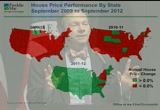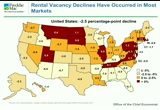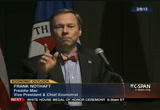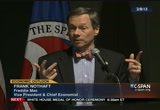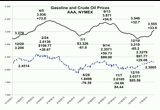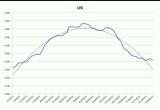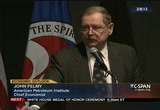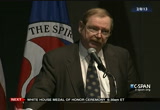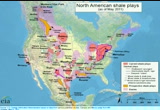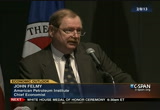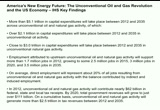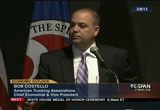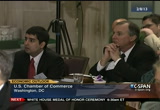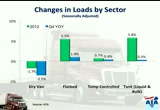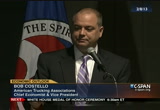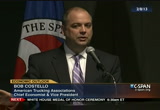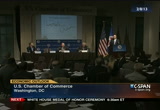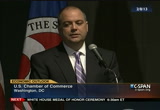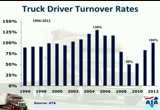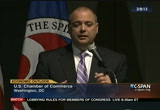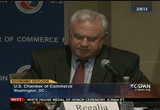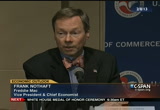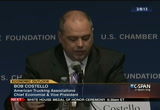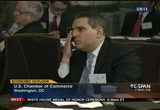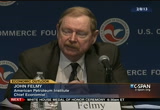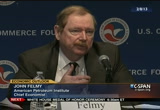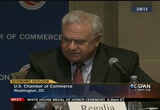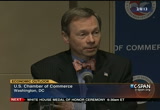tv Politics Public Policy Today CSPAN February 12, 2013 1:00am-6:00am EST
1:00 am
many times we find out because the subs have not been paid by the crimes, to adjust walked off with the money. host: here is a headline from the baltimore sun -- what are your thoughts on this? >> over 50% of the funds go to the afghan military and now the local police. they're trying to emphasize the local police. we will be looking at how we bought and paid for and how we support the local police which will be very difficult. host: why? guest: [inaudible] host: when they use the word
1:01 am
lifeline, what does that say to you? >> guest: that is the difficulty. how they get fuel and structure, to the local police. a lot of these local units are in small villages and difficult to get to. they may be in trouble and they -- and maybe because they're out this is the firstrefus indication of problems. caller: i am calling for mississippi. [indiscernible] i do not want them over there. i cannot understand why -- what
1:02 am
they need to do there. just think what that were due to our borders for education of our children. it does not seem fair and all that we have to go over there and you soldiers for this purpose. guest: that is the decision that the policymakers will have to make. why we're there or how long we stay, are decisions above my pay grade. i do not avoided but my job is to look that now that we're there, are we spending the money well? the policy decision is for congress and the senior executive branch. host: sounds like our tax dollars will be going to afghans for decades.
1:03 am
guest: the tweet raises a good point for how long we will be there. i think people keep thinking about december 2014. troop drawdown will be december 2014 but as an afghan told me and as general allen told me, the world does not and december 2014. there will be a u.s. presence. military, maybe smaller. but there will be if anything a bigger and more important presence and that is the reconstruction. we will be there. the tweet is absolutely correct. we plan to be there beyond 2014. host: what about you, your office? we are temporary agency.
1:04 am
we're set up to handle this agency. at some point we go out -- and existence and what is triggered, if the amount of money not spent falls below to leonard $50 million, there is no need for rest, congress said. we go out of existence. and when that happens, the normal function. that function -- is small enough that it will happen. host: when will that happen? guest: i do not know. it could be yours -- years. host: did you talk to general allen? -- i talked to him through a phone and e-mail. he was a great support for our team and we need the military not only for protection but also to identify problems.
1:05 am
he identified certain problems. i got to give general allen and his team credit. nobody likes an inspector general. particularly an independent inspector general. it is a little prickly relationship we have with everybody. but general allen always took all of our reports seriously and did what he could to fix the problem with identified. i am so happy about that. and i wish him all the best. >> that is the headline in "the baltimore sun." the job of ending america's longest war. general john allen in the picture as well. resigning were stepping down from that post. we'll go to jeff next. caller: good morning. you got a great show. good morning, inspector general.
1:06 am
i have a friend from wyland -- long island. her son has done three deployments in afghanistan. what was told to me and also was given to congressman king in new york's about this was that the magazine's that the soldiers are using in afghanistan are jamming and putting their lives at risk. and congressman king from new york has been evading that particular question and they're using the vietnam era magazines. they're jamming and again, they're putting their soldiers at risk.
1:07 am
caller: i have not heard anything about that allegation. guest: if you do have allegations i would send that over to the dod ig. i do reconstruction. the actual fighting, the dod ig is there concern. if there is a concern about weapons our u.s. troops are using. republican caller. caller: thank you for taking my call. this is my second call and i am very nervous. i can to stop the money going in? the amount of money you cannot account for, some track that from the amount that karzai would be getting or whoever
1:08 am
would be getting. until they can account for the money themselves. have people out there who are working and they're being paid. they should not be paid just like we hear in the united states trade we do not get paid if we do not work. guest: question. i cannot control the money. i can expose problems. we have exposed problems like that and have made recommendations that should be -- they should not have increased funding or lower the funding. we did a major audit on petroleum oil lubricants. it is billions of dollars that we give basically our purchasing petroleum oil and lubricants for the afghan national security forces and we took a look and we could not find any justification for spending the amount. additionally could not find a justification for spending the amount. we told congress to do it.
1:09 am
congress is the one that can turn that spigot off. i can only recommend to congress and if you look at the quarterly report and i highly recommend that the cholera and other colors go to our website and look at the report, look at those questions, and it resonates with them, if they're concerned about it, it gives you good -- a good way forward. what we're saying is now is the time. we had the best opportunity in the world to improve reconstruction but it is an opportunity for congress and executive branch to stop, pause, and rethink how we should proceed, especially as security changes this way. host: give this a successful story of a program. guest: if you look at the education system in afghanistan, if you look at the health system, it was in shambles.
1:10 am
i think very few kids were going to school in 2001-2002 timeframe. tremendous number of kids now going to school because of u.s. assistance, international assistance. what is more important is the girls are going to school. likewise with the medical system and health care system. it was in shambles. there was nothing going on. a lot of u.s. taxpayer dollars and international money and health care is improved. is there a long way to go? yes. those are success stories. in many cases they answered -- asked those questions and answer them correctly. when you do ask the questions and answer them correctly you are more likely to succeed and fail. host: talking about the seven questions in the report. there is on your screen. get a better idea of this report and began to yourself.
1:11 am
$87 billion authorized for rebuilding in afghanistan. >> in a few moments, a discussion about journalism and digital media of with the publisher and editor in chief of "and the republic." . on debttisan group o reduction. and spending cuts in the defense industry. and the state of the state address. >> several live events to tell you about tomorrow. a senate judiciary subcommittee holds a hearing on producing gun violence here on c-span at 10:00 a.m. eastern. before that at 9:30 a.m. eastern, on c-span3, the senate armed services committee on the impact of sequestration. members will hear from deputy defense secretary ashton carter and members of the joint chiefs of staff. the armed services committee
1:12 am
will meet again tomorrow to vote on the nomination of chuck hegel to be secretary of defense. also on c-span4 at 2:30 p.m. eastern. >> she said the first lady has a podium and she chose to use it. i think that was her quote. really knowing that, it was after me the presidential radio address about this, about the treatment of women and children in afghanistan by the taliban. i was here visiting jenna and we went shopping. elease at the cosmetic counter in the department store came up and said thank you so much for speaking for women in afghanistan. that was really the first time i thought, they heard me. i think i knew intellectually
1:13 am
that the first lady had a podium but i did not really know it until after that. >> the new series, first ladies, influence and image. the first of its kind project for television, examining the public and private lives of the women who served as first lady. season one begins next monday, president's day, at 9:00 p.m. eastern and pacific. >> now, discussion about journalism and digital media. the publisher and editor-in- chief of the new republic spoke at harvard's kennedy school for an hour. >> be sure to turn off your cellphone, please. >> hello, i'm alex jones.
1:14 am
we're very glad to have you with us today. it is my pleasure to welcome hewes to the ranks of the ink stained wretches of this world which he has entered, world stage in tradition. today's interview in conversation will be recorded by c-span. i would ask you to be mindful that when you come down to ask questions later. those of you are interested, you come to these to mike. shughes.ag is #christhugh he is someone who is from hickory, north carolina who got himself to harvard and i said a
1:15 am
ever made of mark zuckerberg. this happened in his sophomore year and he told me a moment ago he was taking five classes a semester while that was going on and still managed to graduate with a magnetic couple of years later. facebook is something that has changed the world. mark zuckerberg was the fourth and you were the fifth. but the thing was, chris hewes did something counterintuitive all the way along the line. he did not leave harvard. he finished and he went to work for facebook and did work there but left facebook in 2007 in
1:16 am
order to work for the barack obama campaign. that was something that was anything but a sure thing. it was something that was consistent with a kind of things that chris coons has been talking about then and ever since which was trying to live a life that was going to have a genuine impact. a direct, positive impact on the world. i think are the words you have used. less than a year ago, he purchased control of the venerable -- a publication of the new republic, also in failing health, and has in the months made an awful lot of dust and cause an awful lot of interest because he made himself publisher and editor in chief, but he is actively engaged in reshaping it and has clear ambitions to make "the new republic" something among the most influential and most important magazines in the country.
1:17 am
he is serious about high-quality journalism. that is the thing he talks about. but his focus is not just about digital technology. he is taking the venerable institution and journalism and looking at them informed by his deep knowledge of digital technology and also with a different set of values that are more traditional. it is my great pleasure to welcome you here. the changing media landscape, smart news in the age of social media. glad to have you.
1:18 am
>> thank you. [applause] it is particularly nice to be back across the street from the house where we started facebook nine years ago yesterday. february 4, 2004, is where we open it up. we woke up and there were hundreds of people on it already. and i thought i would talk a little bit to give you a context on what we are doing at "the new republic" and how i see the digital media landscape in 2013 and then open it up for questions and hopefully get a good dialogue going. the first question people ask me all the time is, why would someone like you buy this 100- year-old media institution like "the new republic" in an age when the wisdom is, print is dying, serious journalism is under threat, so why would you be crazy enough to take this on?
1:19 am
it has got to be either a vanity project or i have got to have some political ax to grind or some ulterior motive. other people look at me like i am crazy. the truth of it is i bought "the new republic" because i believe in the power of good writing to shape the world. that sounds incredibly idealistic. it is. it is lofty. but i am not ashamed of it. the people we have at "the new republic" embarking on this project now are a pretty idealistic group. i follow in the footsteps of the founders of "the new republic" 100 years ago. if you look back at what they were riding when the magazine was starting, they, too, were pretty idealistic. they were starting a magazine just as war was breaking out in europe.
1:20 am
they, too, brought a sense of hopefulness to their project. one was quoted as saying, the purpose was -- in the realm of our readers' convictions. what does that mean for us? our core editorial focus is to challenge our readers' assumptions. doesn't all media do that? in 2013, it does not. on one end of the spectrum, we have where newspapers used to be the dominant method, but it has grown.
1:21 am
it is now "the new york times," the "huffington post," "the daily beast." there are sites that give you information about what happened yesterday. the headlines about what you read. at the other end of the spectrum, historically, there have been magazines, which have been thought of as being largely about storytelling. think about "the new york times magazine," or "the new yorker," or other venerable books, other venerable publications, which take time to read, and a patient and educated audience.
1:22 am
for us, we are trying to position ourselves in the space between these two. the goal at "the new republic" is to do great writing, the kind that is good if not better, but to do it about important and timely topics that our readers want to know about. there is a level of urgency to the type of journalism we want to do. everything we publish editorially, we ask ourselves, why is this important? we do not want to just tell stories. we do not think most modern consumers of news want stories for the sake of stories.
1:23 am
the great riding is important, but the news has to be about something important and that matters. in the past year, we have done a lot of research and have found this is what readers want today. they want great writing, but they want it to be highly relevant to the topics already in mind. it is not just content that is enough for us. we started doing this, to build a type of technology.
1:24 am
this will be a constant, ongoing project. because of how many devices exist, how many different devices consume content, we have tried to adapt to how people are reading. the vast majority of people interface with "the new republic" digitally first. we have to million monthly. even before you redesigned website, 20% of the folks, from mobile devices. we build a web product which is responsive to the browser you are using. we are using the same content management system and the same things on the back end. when the reader goes to it, we know if you are reading on your
1:25 am
iphone, android device, ipad, it adapts to the experience. we have also added a lot of small features which, some of them came out of what we wanted as a team in reading and some came out of the conversations and research we did. if you start reading a 2000-word piece at your computer at lunch, you can take it back up where you left off on your phone. if you start reading something over the weekend and you want to read it back at work, we know where you were and we can take you right to the bookmark. if you are committing on a treadmill, or want to play it in the background while you are at your desk, you can listen to it being read to you. and ipad app, there is a laundry list.
1:26 am
we are not just putting it on a website and calling it a day. we are putting it on the web site, trying to understand and go to our readers where they are reading it and have an editorial staff continue to engage in the conversations happening after the content is originally published. at our new web site, you can do footnotes, and a lot of writers have a lot of ideas that do not make it into the text. they can now put footnotes in things. they can add little comments in the margin. it is also a place where we can continue to curate the social conversations that are happening after a piece is published. the old model would have been to write a piece and it comes out in the newspaper the next day and you are done. now, you write a piece and posted on the web, but not only
1:27 am
are journalists responsible for promoting it, but also for engaging in a dialogue with people on twitter and facebook, people who hate it and loved it. if we have a piece that makes it on to john stuart as it did last week, along side of a common with somebody saying this is completely wrong, missed the whole point, which is an important and dynamic. the conversations after the piece is where a lot of impact can happen. in all of this, there are two major questions about our work and whether or not it can be successful, trying to take serious journalism and adapted to a digital age. the first is that in the age of twitter and facebook, are
1:28 am
people really seriously interested in reading quality journalism? this is one of my favorite questions. i feel like my own background in the world of social media hits up against the world of serious journalism all the time. what we see in our data is that social media is not actually competing with the attention span of people reading longer pieces, or more substantive quality journalism. more often than not, it is enabling that to happen more increasingly. before social media, we would have had to rely on just our brand to have people come in and type newrepublic.com into their browser.
1:29 am
because we are enabling people to read our stuff and share it and attract a larger and larger following, a lot of readers are brought in that have not known the brand before but who are excited and interested in reading it. over 20% of our traffic is now coming from twitter and facebook and reddit. that is about double what it was a year ago. part of that is our social media strategy. a lot of that is the evolving nature of the internet and the way people discover our content. another data point on this is pew is doing incredibly great research on reading in a digital age. one of my favorite studies to cite, because it is so mind-
1:30 am
boggling, came out in the fall. they were looking at reading amongst people who were 16 to 30. what they found is that those people were actually reading as many if not slightly more statistically as many books they had in the past. reading books was not down among said demographics. you are just as likely to have read it on your mobile phone as you were in print. there is a wrinkle there. print may have been hired. the mobile phone was higher than ipad, or any type of tablet, and higher than any other message you would assume people are moving to ebook. there are people who are reading full on books on their phones while they are waiting in
1:31 am
line or in bed or wherever they may be. that is a key way they are consuming this long form type of content. people are reading full books while in bed. that is a key way they are consuming this long form type of content. they are consuming at the same rate as they have historically. the first approach made it as easy as possible to read on iphone. even though it seems counterintuitive, who would want to read a 2000-page piece on iphone, more and more are interested. the second point of view is around our ability to monetize. and to be a successful business. on this one, i wish i could even pretend like we have all the answers. we have some hypotheses that we are testing. it is going to take some time
1:32 am
to know if our hypotheses are right. it requires a certain amount of patience on these questions. the way that we are thinking about it, that i think about it in particular, outside of a few highly professionalized verticals, things like finance, sports, very clear verticals, people are not generally willing to pay for access to content. in a digital environment. they are interesting -- they are interested in supporting brands. i think they are interested and still willing to pay for experience. experiences are different than access. to be a little bit more precise about this, the old model used to be you give us $35 and we
1:33 am
give you 20 issues of print. for a very long time, until the web and all the business models were disrupted. now, our model is you give us $35 and you get print but you also get our experiential products. it did -- the digital colom is all the things i was talking about before. unlimited access, commenting, several things in that list. you get access to subscriber- only events, which we are doing at least once a month in major cities and some secondary markets, ann arbor, austin, places where there are a lot of people interested in the type of journalism we do. whether or not that will be enough is an open question pri
1:34 am
is certainly part of the trend where journalists are not just researching and writing. they are researching, writing, promoting, engaging in dialogue, and being important participants in events and interacting with their readers. other brands in our field have moved on to cafes, retail, particularly monocle, 20% of their revenue comes from their stores, which they have dozens of around the world. and there are still other ideas. from mice -- from my perspective, an era where they -- where there were sizable profits in this industry is over. the second part of the 20th century. we now have to adapt to a different kind of business. it is a double bottom line
1:35 am
business. that is the right way to think about it. we have a mission that is important to the world. at the same time, we have a profit mission. we have to find some business model which will return us to the point of prosperity that was the case 20 or 30 years ago in this industry. i think it is wishful thinking. to say a word about advertising, the advertising market is very slowly changing and shifting. it is a challenge for us and everyone else. one of the things i am focused on the most is trying to help advertisers focus on real valuable metrics and not just the top line, superficial ones that most people ask about. things like page views or unique visitors do not necessarily tell you anything about the level of engagement or how good a digital or web
1:36 am
product is. if you want to boost page views or unique users, anything past headlines, that is all day long. you can get lots of people to click on a headline. they can count it as a unique user, but whether or not the journalism is quality, whether or not a person is lingering there and interacting with an advertiser's content, these questions are asked by topline metrics. i have started to engage with a lot of the advertising community a bit more over the last few months. a lot of people are thinking creatively about new solutions here. more often than not, custom solutions are built per brand, per advertiser, not just for the new republic. to understand how these products exist, what the interactions are like, and how
1:37 am
they can monetize them. all of these ideas -- the last thing i will say before opening up for questions is one of the key things we are trying to do in the republic, which has very much been in the valley of the silicon valley for a long time but not so much in this industry is taking a highly experimental approach. in silicon valley, the expectations for a venture capitalist is that she or he will invest in 10 different companies and hopefully one of them will be a great success, two of them will be ok, and more often than not, seven of them will fail. but that is okay. for us, we are trying lots of different ideas. i do not expect any one of these, from a technological perspective or business
1:38 am
perspective, to be a silver bullet and for us to discover the cure to all of our ills. we have to create a culture inside of our company. this is the same thing for giants like the new york times or small, emerging blogs. you have to create a culture where there is a high amount of experimentation. where we continue to experiment with new ideas to see what will succeed. that is not something that has necessarily been part of the dna or culture of the world of journalism for a long time. there are a lot of brands and people out there that are trying to do that increasingly. as long as that continues to be the case, it gives me a lot of optimism not only about the state of what we're doing, but the state of the injured -- the
1:39 am
industry in the future. >> we will have a conversation for a few minutes and then open it up to you. on the business side, what are the things that people find unpleasant in buying enterprises that are losing money? do you have a tolerance for basically funding lawsuits for a while? you have spent money. >> what is the definition of a while? >> have you thought about that or are you going to let that take care of itself. >> i spend them majority of my time on the business. >> doesn't have to be profitable? >> i think it should be profitable and it is up to our self to find a profitable model. i am not saying that we are going to be making a lot of
1:40 am
money hand over fist. i am in this for the journalism, not to make a lot of money for myself. the profitability is synonymous with sustainability. once you get the company to a point where the journalism is to a national marketer demand our products, then the companies can leave the question is, how long will it take us to get there. there is no way that we can get there without serious investment. if that means losses this year, it may mean losses next year. i do think we can sustain it this year and next year. >> the idea of heaven was 1 pound of more than he spent and the was the other.
1:41 am
the point is, that essentially says sustainability is more of a break even that is a different stand and one that will not be as hard. in the business of journalism, this is the journalism. the standard for profitability is significantly more than that. that is going to be easier and that is good as far as those of us who cares about -- who care about the journalism. i want to talk to you about the journalism for a moment. what kind of made journalistic enterprise the what the new republic to be. do you want to be there -- a place where the reporting is considered to be strong, where the analysis and opinion are strong? how do you weigh those and imagine how you mix those things?
1:42 am
>> historically, we have had a lot of that kind of journalism. before the internet, the role all opinion journalism was incredibly important. if you were somebody trying to get your opinion out there so it was part of a mix and conversation in washington, and you had to go through a handful of print publications and have it be included in those pages. it is worthwhile to remember because it is so different from the model of the universe that we live in now. if you have your own blog, somebody else would be happy to post it for you. you can also go to twitter and all of the outlets for people to share their opinions.
1:43 am
plenty of opinions. the shift that we are trying to make, we will continue to do some opinion journalism to be part of the debate. where the market demand is and what people really want is the type of journalism that is more contextual, deeper journalism that searches for new points or exposes new ideas, not just sharing another opinion about what is happening in the world. that is where the hole is in the marketplace. >> i have read about your experience as the editor in chief at the new republic. you stopped a magazine cover because you found it to the -- i do not think that is a small
1:44 am
thing. i would like to know how you're thinking works and what were you trying to do? >> we do not call people names. we can have intelligent debate about a lot of different topics and call people out, but calling people out is different than calling people names. i bought the magazine on a thursday and this was the next week. i literally did not even know where the printer was, let alone how the logistics around it happen. it sounds quite dramatic. i got sent to cover and i was like, we need to change that. by that point, it was already out at press, which i wish i would have known. >> it would cost you x in order to do this, i would imagine. >> because the new republic circulation network is not as large, the cost was not significant at all.
1:45 am
but you are going to highlight, i think it is important -- there are lots of places on the internet where you can call people names. there are not that many were you can call people out in a substantive, thoughtful way. of course, people do it. but some of the brand perspective, we have to do reported journalism and the types of opinion journalism that is well-documented and well-thought out. if you put a word and a headline that call somebody a nut or baby or whatever, you immediately turn them off. if you are trying to get the other side to listen, trying to engage in a debate, the first thing that you should not do is call them names. if there is some difference there historically, it is an important point.
1:46 am
>> the thing that is interesting to me is, the headline referred to wall street guys as crybabies. you found that -- you changed it. >> i do not even remember. >> pliers? -- whiners? >> i honestly do not remember. one of our reporters wrote a piece on why so many people in wall street were so upset about the administration and a lot of the policies that barack obama had been implementing. you can argue that the administration was much more sensitive to wall street than it was to main street in the course of the first term. incredibly well-reported. he had talked to all of these hedge fund guys. the question was, do we want to call them out and force them to think about whether or not their hands are reasonable?
1:47 am
you are not going to be able to do that if the first thing that they see is you are calling them babies. >> it is a part of the web now and part of the culture, especially of magazine journalism. they are calculatingly provocative. they need to get people to read them. the values of the web journalistically are far more than something that would be considered safe. >> you are using unique as your master, like most countries do, then you want to write things that are provocative, enraging, because it works on both sides. it gets the people to agree with that and they want to read it. it angers the other side. if that is the goal, a lot of journalism on the web does do that.
1:48 am
there are a lot of people like myself who, when it comes to opinion journalism, i feel like i have plenty of it. everyone has twitter and i love a lot of the people that i read. i have plenty of different opinions and perspectives. what we have found in a lot of conversations and research we have done is that people want new sources that are thought- provoking, not necessarily unbiased, but in our category, i am talking about all types of news consumers. politically savvy people. they want unbiased, highly- reported coverage. >> those of you have questions for chris can come and line up at these two microphones. >> just to clarify that last point, it is important that we
1:49 am
are focused on a relatively specific group of people. college-dedicated folks who follow a somewhat closely and are politically savvy but also want to know about film, literature, social movements. that level of focus it enables us to have that perspective in a different way than if we were running a television network or focusing on a larger, more diverse demographic. >> i wonder if you could address some of the opportunities you see on the horizon in terms of engaging new republic audiences, whether it is the next generation of crowds sourcing or whatever it is to engage the audience in ways that intersect with the double lines that you described. an impact both on your social
1:50 am
consequence as well as your sustainability. it begins with engaging them in the journalism. >> what we are trying to do is go to our readers rather than necessarily create new products to come to us. being very much engaged with the conversation, particularly on twitter and to some extent on facebook, is a real important strategic priority for what we're doing. we are experimenting with ideas are around how to use technology to engage in those dialogues, something like google hang out. we use that a lot because we have about 25 folks in new york and 30 in washington. we have tvs in conference rooms and have them connected with gul will hang out. it means you can going to a
1:51 am
conference room and maybe not have a face-to-face conversation, but it is the next best thing. we have a culture of people using google hang out all the time. what if our reporters were engaging in a dialogue? one in new york and one in washington. experts talked to some of the people reading it and had criticisms with it. there are opportunities there. will that work? will people want that? i do not know. when i talk about a culture of experimentation, these are things i really want to try to see if it makes sense or does not. >> the social media environment is in place where we have to go first to engage. what we know is important is engaging on twitter and to some
1:52 am
extent, facebook. >> our next questioner is a colleague who i have not seen in a long time. michael, who you may are my for -- you may or may not know, i suspect he will be writing for the republic. >> i have written for the new republic for many years and i am very enthusiastic about what you are proposing to do. it seems really good to me. the one question i had was about the association of the new republic with liberalism. for the better part of a century, people think about the new republic as a liberal magazine. i am wondering what that mission means to you and how it will change under your leadership. >> what i do not want is for the new republic to have an editorial line where we get in the business of hiring and not
1:53 am
hiring people because they agree or disagree with that particular viewpoint. what i do want is for us to practice the type of journalism which does not necessarily pertain to be -- where the journalists pretend not to have certain opinions. one of the issues structurally with media today is there is still this he said this, she said that, let the reader decide. the type of journalism we do, what is great about our reporters is they engage, they learn, and they have an assessment. hopefully they include that in their peace. the vast majority of our readers and writers are generally liberal folks. pretty sure most if not all of them voted for obama. i think they share a similar world view as our readers.
1:54 am
i did not buy a magazine to expand a liberal outlet. i bought it for the type of journalism that we can do inside it. different people can say different things about how that intersects historically. we did some quantitative research around this question. do you know the new republic? yes. do you think it is liberal or conservative. most people thought it was liberal. it is really interesting because a lot of folks will say they used to support the editorial board before the iraq war. it is very conservative. other people will have the opposite viewpoint. what i end up saying is we do not have a party line anymore. we have a lot of reporters, a
1:55 am
lot of different opinions. each one of them can help. some of them you will love, some of them you will hate. >> are you going to write a column or have any editorial voice? >> i will probably write some. i have not yet. i am focused on the business and how many years of losses we are willing to put. i definitely will right, but it is important, in an initial for me to be clear that i did not by the new republic and i am not here to amplify my own voice. i am here to empower the people who do this for a living. >> i am the editor in chief at the harvard review of latin- american people of journalistic descent. you're doing an amazing job of trying to blend of journalistic cultures.
1:56 am
many of my students know the new republic for the movie shattered glass." detected a major breach of journalism ethics in which a journalist was making things up. in the internet culture, there is much more of a culture of passing things along and repeating things. in the print culture, that is what the new republic defended by firing glass. truth. i was wondering, as you take over this magazine, what does your fact checking process look like and are you writing a new code of ethics?
1:57 am
in that code of ethics, how are you taking into account trying to read these two cultures? >> fact checking is incredibly important to what we do for two reasons. one, whatever we are publishing, we want to make sure the fact that we are siding are right. -- are citing are right. it is incredibly important for us as a company, for our brand. when the key differences between us and a lot of the other places you can find content on the web is that we do have a brand. we do have a history. people have to be able to trust the facts are right. whether it is with stephen
1:58 am
glass or a couple of other episodes, there have been lapses at the new republic historically. as a result, people are being even more on their toes to ensure that that does not happen anymore. we have a pretty rich -- robust reporter-researcher program. they are fact checking their work. several times through. it is important because of the history. it is also important for us as a brand. we have to have people trust us. >> does the stephen glass episode still linger in the rafters? just mindful of something. >> i think people are more mindful of the integrity of their journalism. most of the people we hire bring such a sense of integrity anyway, but because of that episode, i think people are more aware. i know it from talking with some folks who were there at the
1:59 am
time and also from the film. it was an incredibly -- it was not -- >> you had the bad luck of it turning into a good movie. journalism ethics now, by the way. >> do you have any plans for europe? thank you. >> international coverage is really interesting. we are trying, every single print issue of the magazine and a couple times per week, to always have international content be in the mix. we have been reported pieces from venezuela, or somebody embedded in afghanistan.
2:00 am
it is really important. the question for us from a business standpoint is the economics. more often than not, it works best for us to work with freelance reporters who are contributing for us. we can get the content, the ideas in the magazine. but we do not have a bureau in kabul or something like that. the international stories are key to having a great magazine in the future. >> are you going to make it weekly? >> we do not have any plans to. historically a weekly. previous ownership brought it down to a biweekly.
2:01 am
i was a little cynical of the format. >> is often enough that we can be responsive to the news cycle. it is slow enough that not every single week are reproducing another magazine. we are able to keep the content relatively high. strategically, we think about it internally, we have a lot more people interfacing with content on the web or on their iphone or ipad than you do for the print product. we make money off of print. it is not going anywhere. we try to keep everybody aware
2:02 am
of the fact that people are coming to the new republic each day, not just waiting every two weeks to pick up the next magazine. >> how will you feed that beast? >> we have invested a lot of capital into traditional online content. we had a reporter go to the consumer electronics show two weeks ago. she wrote a 5000-word web-only piece which was absolutely fantastic looking at the culture of las vegas and ces and theory and philosophy and some of the people she met. it was a really great piece. it will never appear in print. it is just on the web. >> i am a student here at the kennedy school. you mentioned the idea of moving away from a uniques as a metric and maybe a way to make a more
2:03 am
financially sustainable system for online advertising. i wonder you could elaborate on that and talk about what that would look like and whether there were any organizations out there that you think are modeled for better measurements. >> it is not that i think you need -- uniques are not interesting. i think spending time on the site is very interesting. we use a few analytics tools. one tool enables us to see not only how many people are reading, but we can see how many people are reading a piece at any given moment in time. you can also see how far down in an article they get. that is really interesting. sometimes you have a great headline that will get lots of people. who would have thought that that many people wanted to know about a topic?
2:04 am
then you will see that 70% of people dropped off after the first paragraph. then you have other pieces, like a wonderful first-person essay, a gun owner, he carries guns in his car, he talks about how he has had to pull them on people, and he tries to explain why so many gun owners feel strongly about weapons and their rights. the number of people who read really deep into the piece was on the web -- it was well over 70%. that is not a number you never know. normally you ask, what are the nique -- uniques on teh article? you can look at comments. you could look at social shares on twitter or facebook. you can also look at retention, which is something we look at.
2:05 am
when people sign us -- sign up on at the mls, how many people are opening them or clicking through? -- emails, how many people are opening them or clicking through? many companies focused on those networks -- i don't. most companies have baked into their profiles. google analytics has it as well. most people still look at uniques. >> i am a former publisher of a non-profit magazine, "harvard magazine and." a consultant to nonprofit media start-ups. i also teach a course on the evolving business models in the media industry. i have a question -- >> i should take that. >> one quick comment about
2:06 am
facebook. about in 2005, a freshman adviser said, you have to get on facebook and see what your students are doing. that was the first wave of harvard administrators joining. going back to the business model, two parts -- when you talk about experiential marketing or experiences that may be able to monetized or maybe part of your monetize asian -- moetization, are you looking at your competitors, like the atlantic? or the nation, a much smaller place? the second part -- and thinking along the experience alliance, what do you perceive as a competition? is it the nation? the atlantic? i hear a broader set of competitive and voices -- competitive voices.
2:07 am
>> the question of experience -- access to content is nice. clicking on a link. experiences are any time you will choose you'll spend time with the brand or topic. that is a pretty broad definition for me. sitting down to read a magazine is an experience. you choose to have that experience, rather than saying, there was at one article i wanted to read in vanity fair. let me flip to page 84. the ipad is a great place to understand the difference between the two. we have a web app experiences in safar, which is about access to content. are there links and things i want to read there? then have the native act, -- app, which we consider experiential, because it is
2:08 am
accelerated, -- curated, a paginated experience. it is fascinating for me to see how consumers thinkings i go back to the research we did -- you ask people read magazines and you say, we did some groups where you say, how do you read something like "a vanity fair"? some people would start at the back. some people would flip pad -- flip page to page. then you ask, what do think about their web site? people would say, "a vanity fair" has a web site? it is a totally different way of thinking about content. one is experiential, and the other, i think, is about accessing certain titles or articles that are there.
2:09 am
also in the experience category, a put audio, -- i put events, audio, some others. whether it can be the feature of the business, i am doubtful. when we look for a business perspective for assets that we have, a lot of brilliant people, a lot of great reporters who know quite a lot about politics and the arts and culture. the question is, how do we use that as an asset? an event is an easy way for us to give stuff that our readers are interested in and subscribers are interested in. we also have the expertise to pare it up. -- pair it uop. on the question of competition -- pair it up. on the question of competition, our competition is probably more of the new yorker, new york
2:10 am
magazine, the atlantic, that type of thought leadership publication, then it is opinion journals. i loved the nation -- i think the work they do is important -- that is much more of the content where the new republic used to be in. it is more of a challenging category. the category with the economist and the atlantic -- those are doing pretty well from a business perspective -- that is where we are trying to go. >> i am a freelance religion writer. one thing i noticed during some lgbt recording, it is a false equivalencies. they were put out somebody from the right, based on the fact they are a colorful character, interesting, without any examination about the veracity of their claims, funding streams, and so forth. the present an article where on the youtube is a photograph or
2:11 am
video clip of somebody saying something inaccurate that is unchallenged. i wonder the moving forward in what your thoughts are about that? >> it plays into what i was saying earlier about having assessments in journalism, and not just saying, he said, she said. this is what they both said. here are some other data points. here is what may actually be the case. >> my name is being. i'm a student here. i have a question about what you're seeing about the digital landscape. you have thought about connecting people on line in meaningful ways. i'm a composer here at harvard. i wondered vaguely thought about connecting creed of minded college kids like myself -- there is not -- creative minded college kids like myself -- what
2:12 am
do think about these kinds of connections and collaborations between students? >> and think it is interesting that facebook historically has not tried to serve that role. groups are more about connecting with the people that you know and who are in your existing friend and family groups. not about finding other people. this is me just watching now. somebody who is unaffiliated with the company. but they have done with the grass surge in the past few weeks, facebook significantly -- the graph search in the past few weeks, facebook has significantly made their search more conducive to human language. you can now search for, say, a violinist at harvard, and contact people.
2:13 am
that is a corner of the web that is unexplored. there are complex human and psychological issues underneath. if anybody can solve it, it is the folks at facebook. graph is a step in the right direction. >> we are almost at the end, and since you worked at facebook, i have to ask you about "the social network." >> is hollywood. it made me wish our dorms looked like a luxury condominium. the sex in the bathroom -- it was very interesting. i never -- maybe, i never saw anything like that. i thought it was -- what was great about the film was that it actually -- for all of the things that got wrong, what it got right was that we were college students at harvard with an idea and we tried something
2:14 am
out and it initially took off. it took time to build. of the hard stuff was not coming up with an idea. it was building it over time to reach the point that it is that today. i think it played into that belief that anybody, college kids in a dorm room can create something that can change the world. >> and transform a 100-year old magazine. chris, it was great to have you here. congratulations on your purchase. the very best of luck. [applause] chris has people waiting for him. he will not be able to wait around to say hello to you all. i will apologize to you on his behalf. >> thank you. >> in a few moments, a
2:15 am
bipartisan press conference on debt reduction. and then, how automatic cuts could affect the defense industry. then gov. john ricketts however theitzhaber's state of state address. and the next "washington journal," will preview the state of the union address. then the center for responsive politics will focus on lobbying rules and restrictions that apply to current and former members of congress. we will be joined by the founder of the treatment advocacy center to discuss his article on how the diegan institute -- institutionalize edition of psychiatric patients is affecting mental patients today. live at 7 in eastern every day.
2:16 am
now a briefing on debt reduction and the federal budget from a bipartisan group of former u.s. senate and house budget committee chairman and other members. the committee for responsible federal budget hosted this half hour event. >> good afternoon. i run the campaign to fix the debt. i am pleased to be here introducing our congressional fiscal leadership council, which is a tremendous group of former members of congress to come together to join the campaign to make the case as no one else can. they have all been there and experienced what it is like to be a policy maker trying to do different things in a partisan environment that have come to make the case why the fiscal challenges are so pressing.
2:17 am
it is still import we were to come with a comprehensive plan to address them. campaign to fix the debt has been around for not very long but has amassed a tremendous group of support. from citizens across the country where we have 350,000 citizens to have joined the campaign, a present in 50 states, active organizations in 23 states in growing, partnerships with 205,000 small businesses, and organizations all coming together in a way the country has to to explain why making tough choices of putting in place the policies that were required to get a hold of our nation's fiscal challenges is so important. i am proud to be joined by this tremendous group of former members of congress.
2:18 am
i am going to turn it over to one of our three cochairs. do you have senator judd gregg and a few other people representing this new council. thank you very much. >> it is a pleasure to be here was so many of my former colleagues to serve this country so well and continue to bring attention to this critical issue, our debt. you cannot fix this country unless you fix the debt. it is that simple. the biggest threat to our prosperity is our debt. our biggest responsibility will be dependent on getting our budget under control. there is a murmuring going on in washington that maybe the debt is not that important, maybe we have gone far enough by doing the budget control act and fiscal cliff.
2:19 am
that is clearly not true. anyone who subscribes to that problem thinks the red sox won the world series last year. if we do not get under control fairly soon and have congress and the president lead us in that area, we will have a nation that is insolvent. that is not fair. it is a great pleasure to participate with is very strong group. it is my pleasure it to turn the roster over to my former chairman and understands this issue more than anyone. that is kent conrad. >> thank you. judd and i did not agree on everything we were ranking members. we had some heated disagreement about how to solve this problem. we were joined at the hip with
2:20 am
the understanding that this is a problem that must be taken on. the economic future of the country is at stake. that is not just our view. that is the view of the chairman of the federal reserve, the congressional budget office, virtually every serious objective economist who has looked at the long-term trajectory of our physical circumstance. i think we have to acknowledge some progress has been made. in 2009, the shared g.d.p. was 10%. this year it is going to be just north of 5%. we have gone from borrowing 40 cents of every dollar to borrowing 24 cents of every dollar spent. what is most striking is not the near term circumstance, the next couple of years.
2:21 am
what is most striking in the analysis most recent is where we are headed in the end of this 10 year window and beyond. this was done for the committee for responsible federal budget. it took an analysis of what would have happened if nothing had been done so far. if we would not have had the budget control act. if we would not have had sequester. if we would not have fiscal cliff discussion. that is the green line. that is the trajectory we would be on that nothing had been done. the blue line represents all of the actions that have been taken so far. that present -- represents the budget control act and the revenue done by the end of the year.
2:22 am
as you can see, that still has us on an upward trajectory with the debt at the end of this decade. what this does not show is what is going to happen right beyond the 10-year window when the debt will take off like a scalded cat. anybody who thinks we can resolve this problem by what has been done so far is not dealing with the reality that we confront. i understand if you are in public life a convenient thing to do is to hope, wish, believe, that you have done enough to deal with the problem. this is not enough to deal with the problem. you can see the debt will be 80% of the gdp. that is the publicly held debt. the gross debt would be about 30 points higher, 107%. why is that a bad thing?
2:23 am
it is a bad thing because it is too high. as you can see, the trajectory is going up at the decade. more seriously, probably the best that has been done was an analysis of two years of economic history. what they concluded is that when you have a gross debt of more than 90% of gdp, your future economic prospects are reduced. your future economic growth is limited. quite sharply so. this matters to the economic future of america. medicare is going to be insolvent in 11 years.
2:24 am
social security is going to be insolvent in 20 years. you are going to pay 75% of the claims on social security or you have to have a 25% cut across the board. anybody who says do i have to worry, i do not think it is really giving it straight. my own conclusion is we have got to reform the entitlements. we have to get them under control. we have to reform the tax system. we need additional revenue in order to get this debt headed in the right direction. that is what this is about. that is what we're urging the president to do, to bring leadership to this issue, to remind people that economic growth is the number one agenda item. part of that long-term is that we give our fiscal -- get our fiscal affairs in order. that is important long term. the cbo affirms that in their most recent reports.
2:25 am
>> i am glad to be with this great group of former members. for all of the great things they have done. i am here today to say possibly the most dangerous thing coming out of washington today is uncertainty. the uncertainty that causes folks all across this country to worry about jobs and to worry about social security, to worry about medicare. the represent defers or districts and states all across this great nation. we have maintained diverse political beliefs. they come to some place where they come with a common ground. you see the kind of diversity today in terms of our backgrounds.
2:26 am
i happen to be the token mom here today. we come here together because we feel the critical nation of what this nation is experiencing in terms of the uncertainty of the steps that need to be taken. we know the deficit is not something that will be solved overnight. we know it will take steps. if we do not look at the kind of trajectory we are seeing here and where we want to go, we will not be able to take steps today or tomorrow to get where we need to be. we are here to urge congress and the president to work and come together to pass a bipartisan tight budget deal that is large enough to put the debt on that downward trajectory. we know anything that will do what we want to do is going to
2:27 am
have to have a major component driving our current imbalance. it is going to have to have discretionary spending, entitlements, revenues. i have to say without a doubt only look at what we have to do, it is not an easy task. when my husband and i are looking at what it is like to be fiscally responsible in our home, what we think of first? we think of our children. we think about our aging parents. we think about things that are important in the road ahead. these things need to be thoughtful but we need to take the steps that will look at the long term in terms of where we want to go and what we want to do. it is important that all of us looked across this great land of ours.
2:28 am
there are multiple families out there that are looking at a debt and trying to figure their way out of it themselves. we have to be able to stand up tall in washington. we want to be able to be helpful in coming up with those solutions. i am proud to be here with this group. to excited about being able come together with lot of good ideas. we cannot allow the conversation to continue. there are many more steps that have to be taken. we want to make sure we're together working with others in washington to make that happen. i am going to turn it over to the congressman from ohio. >> thank you. i think senator conrad and i are the fresh faces to spiral out of the house and senate, but retiring at the end of the 112 congress.
2:29 am
retirement is pretty good. i can sit down with silverware. i am excited about retirement. i belong to the "go big or go home" coalition. since we did not go big, i went home. that was pretty sad. if you look at what was lost, there are moments in history where the stars should align and people of good will and leadership can actually accomplish a big deal. the tendency is to the can down the road. when you delay sequester you
2:30 am
delay the recover. when you institute a tax increase that only raises about $66 billion a year, which is about the same amount that went out of the door for hurricane sandy, you lost a golden opportunity to deal with it. the great thing about washington is the opportunity has risen again. it will now occur not on the debt ceiling but on the sequestration discussion. only with a balanced approach in an orderly way takes care of the alternative minimum tax. it takes care of the other cats and dogs that are out there. can you not have the major disruptions by get to where everybody is where they want to go? they would let you pick one where they do not need to raise revenues or they do not have a spending problem. both are patently incorrect.
2:31 am
tomorrow is the state of the union address. the president has an opportunity to use the leadership of his office that only the president of united states can use. i think this is very much open to president obama as he takes to the house. he talks about the desire to work together for a true balanced approach, not a balanced approach that is not balanced. he could be met halfway by john boehner and the house republicans. that saves the country. it is my pleasure to call up my former budget committee chairman. it is nice to be part of a group with people you have read about in history books. this fellow i did serve with.
2:32 am
jim nussle. >> thank you. hopefully not in the history books in just yet. i am jim nussle from iowa. i am the former house budget chairman. i learned a lot from watching them work together. and the people on this stage. they have all had a hand in working the process to a successful conclusion many times while the serbs in congress. i am co-chair of the committee for responsible federal budget. we thought it would be important to tap the resources of people who have actually been there, done that, had a number of teachers to their credit of having accomplished deficit reduction. this seems to be a foreign concept to our friends in the united states congress.
2:33 am
what we wanted to do was come together and have a conversation here yet maybe we have something to offer as former leaders. maybe we have something we can contribute to our friends back there as far as concepts. reform proposals. we see move forward or an introduction or two. some of these folks do not even know each other. half the congress, 60% of the house, was just elected within the last two years. they do not know each other in the house. many in the senate are just getting to know one another. maybe an introduction or a concept. those are ways that we hope we can contribute.
2:34 am
fix the debt has many councils. this is not our first. we have a ceo council of 150 members that are from some of our biggest and most popular corporations that you have heard of that are very well known. we have 350,000 active individual members that are just people that have signed up that want to help. they want to be part of this in a short time. that is quite successful. 250, 000 who want to be part of the solution. we have 83 members of this council and growing. everyday we ask members to that organization of folks that want to help work on the solution. while we are all formers, a lot of different titles are concerned with the future. that is it the security
2:35 am
challenge of our lifetime, if this debt comes in negative ways we all know it could. we are former members of congress but we are former husbands and wives and people concerned about are on retirement or owning a home or making sure an elderly parent is taken care of. while a lot of things were current small business people and recurrent citizens, they do not want to be on the road to the country's ruling appeared want to get in the game. we know leadership requires not just the person in the arina but the people behind them that provide the spine and momentum
2:36 am
and the accountability for solving any problem in our country. we are not willing to be a bystander to this process. we decided to come together and be a solution if we can in giving ideas, providing backbone and momentum to this process. these folks have laid out some of the details of the challenges our. it is not easy. we know that. we do know that unless the process starts, it's a never conclude. what has been missing is the conversation in the halls of congress and the coming together of all members, not just those that come together and try to work out an agreement but every single member, no matter how long they have been there or how new they are to the process have something to contribute.
2:37 am
by joining together, we have provided some momentum that people like ourselves can do it on the outside. hopefully they can do it on the inside. with that limit think all of our colleagues for being here today. let me turn it back to mya for a few questions from the media. >> thank you very much. i want to echo what you said. i just look at the stage and i think about how much wisdom there is in terms of helping to get this deal done. nobody is saying it is easy. it is not always easy to explain why. the debt has become the sand in the wheels. we cannot move forward on any of the important things we need to do to make our economy grow. it is not putting in place a
2:38 am
debt deal. it is putting in place the right debt deal. you have so much wisdom that put it in thoughtfully. these are the kind of things that will help grow the economy and not tamper our long-term investment or the way our taxes can work. what we need is real political leadership. i thought how with everything that's been happening how it is important to get the right savings, the kinds of things that will help grow the economy and not to hamper our investments. what we are building is a campaign that in no way can replaces policy makers who will be the ones to make the tough choices, but the support system of people who understand it is important we get these things done. i want to thank everyone for stepping up. we have time for a question or two. >> a question for anybody.
2:39 am
what specifically do you hope the president will say in the speech tomorrow? >> i would hope the president lays out the case as to why number one on the agenda is economic growth. beyond that, i would hope he would lay out why dealing with a long-term debt challenge is critically important to long- term growth. i do not know if you look at the most recent cbo study that looked at three different scenarios. if you added $2 trillion to the debt, but what happened to growth, short term, long term, if you are going to reduce it by $2 trillion or by about $4 trillion. interesting as if you look at their conclusions. in the short term, you have to acknowledge, if you want to be credible, if you cut too sharply, quickly, that has an adverse effect. we saw that on the fourth
2:40 am
quarter. negative economic growth. the thing we have to keep our eye on is if you do not reform entitlements, this debt explodes on you, and that hurts your growth in the future years in those out years. economic growth is directly linked to what we do about deficits and debt. you got a circumstance, medium term, longer term. what this chart shows is we have already done $2.6 trillion, that is in the budget control outcome of the sequester, the revenue piece just put in. what is needed to get you on a track to the debt going down at the end of this budget window is about another $2.4 trillion. we might all have a different mix of how we would do that. i think we have been light on the revenue side. i think we have been light on
2:41 am
the reforming of entitlement side, in terms of the spending. that is the 800-pound gorilla. the thing that threatens is the health care accounts. it is not impossible to do. i gave a speech my last day on the floor and talked about if he took -- the speaker was talking about in terms of spending reductions, he was talking about $500 billion and health care accounts, but nobody puts it in perspective. that is $500 billion out of $11 trillion, 4.5%. we cannot do for 4.5%? of course we can. those who say the speaker is making an impossible demand on the spending side, really? we cannot do for put 5% in reduction in health care accounts in the next 10 years? of course we can. the same is true on the revenue
2:42 am
size. the president wanted an additional $1.6 trillion. what is the base that it applies to? $37 trillion, and we cannot do 4% more revenue? of course we can. if you took the speaker's spending plans and the president's revenue plan, put them together, you would have an overall plan that would get us on that downward slope on that red line that you see there, that was provided for in the committee for responsible budgets. >> a comment on what the president might want to say? i think he may want to open the door. this cannot be done by one side. these big issues such as medicare, social security, medicaid, tax reform, weigh in. they will not buy in if that think the answers are not fair. i would hope he would open the
2:43 am
door to participation from both sides of the aisle in an aggressive way in trying to move to a solution, and the opportunity for will sit there, to replace the sequester with something significant, and he has a great chance to say how we can do this together. >> senator conrad, trying to do some math in my head as you were talking. it sounds like you are saying we need to go toward $5 trillion in debt and deficit reduction, which is over what we were seeing in the $4 trillion plan that president obama was touting in his weekly address. what is the target number here? what do we need to hit to start seeing these lines level off? >> the goal posts have moved. when we were doing bowles-
2:44 am
simpson, we thought we were going to need to do $4 trillion. we have also had other changes that were made. in terms of the underlying estimates of the strength of the economy and what kind of revenue is throwing off and expenditures the federal government experiences, things like disaster things like the disaster in new jersey and new york. now the basic numbers that the committee for responsible federal budget came up is to get us on a path that is declining in terms of debt as a share of our gross national product requires a package of $5 trillion in total. we have done roughly $2.65 trillion. that does not count the continuing resolution from 2011 that could be argued as counting as well. if you look at cbo's most recent numbers, that is about
2:45 am
the size of the package you need, somewhere in the $5 trillion range, to get this debt going down as a share of our economy. we are still having a debt at the end of the time of 70% of gdp. that is 100% of gdp as a gross debt. the guideline is what bowles- simpson would have done. it would have done significantly more. >> i am going to close on the point that that question reminds us, which is simpson- bowles can out two years ago, and it recommended we saved $4 trillion, and some progress has been made, but the passage of time has added on more years, bigger amounts of savings needed, and what used to be $4 trillion now would be equivalent as we have moved
2:46 am
forward above $6 trillion. you look at these programs that so clearly need to be fixed and reformed. it is two years lost of not fixing our tax code so we are more competitive and raising revenues and a smarter way, two years lost of not facing and changes to medicare social security. so waiting has so many costs from weakening the programs which need to be fixed to not putting the stability into the economy which we believe will help a real recovery take off. the urgency is real. the support network is broad. i hope you feel free to come up and ask any individual questions of that tremendous group we have today. thank you so much for turning us at campaign to fix the debt.
2:47 am
thanks. >> more now on pending federal budget -- federal budget cuts known as sequestration. a coalition representing the defense industry outlined their concerns in the 45-minute briefing. >> welcome, and good morning, everyone. i am emily holubowich, executive director of the coalition for health funding and ndd united. our programs are functions provided for the benefit of all, including public health and safety, law enforcement, education and job training,
2:48 am
veterans' services, medical and scientific research, weather monitoring and environmental protection, natural resources, housing and social services, and transportation and infrastructure. ndd united is pleased to join with the aerospace industries association in this effort to stop sequestration and find a balanced approach to deficit reduction that does not include further cuts to discretionary programs. both defense and non-defense programs are equally critical to economic growth and the safety and security of our nation. these discretionary programs are not the reason for our growing debt, and so far they have been the only place lawmakers have been willing to cut, by $1.5 trillion to date. non-defense programs alone have been cut by $900 billion, bringing spending on his programs to levels not seen since eisenhower was president.
2:49 am
as we saw from the white house memo on friday, and as you hear from our panel today, cuts in discretionary programs alone not only will not balance the budget, they will cripple our ability to grow our economy, and provide an apartment where all americans have the opportunity to live healthy, safe, and productive lives. that is what brings us together here today, because sequestration is about more than numbers on the ledger. they are real people behind these numbers. these cuts have consequences, and every american will pay the price. with your food inspectors, which will be more susceptible to food-borne illnesses, greater risk of disease outbreaks, with fewer air-traffic controllers, flights will be curtailed, classroom size will increase as teachers are laid off, national parks will close, and we will be less safe with fewer police on the street and we will wait
2:50 am
longer to care for debilitating diseases like cancer and alzheimer's. today ndd united is sending to the white house a letter signed by federal, state and local organizations, including those represented here today, to stop the political brinksmanship, to stop cutting for cutting's sake, and to start working for together on a balanced, meaningful solution to our nation's debt. i would like to invite our panel to share more details about the devastating impact of sequestration on defense and non-defense programs. we will take questions at the end of the presentation. and full bios for our speakers are in your press packet. we will begin with marion blakey, president and ceo of the aerospace industries association. i want to thank marion for the association's support of ndd
2:51 am
united and her leadership in bringing defense and non- defense groups gathered for the first time under one big tent. marion? >> thank you, emily, and i cannot tell you how pleased we are to be here to be talking about such an important topic. i'm marion blakey, president and ceo of the aerospace industries association, and we are proud to represent the 1 million highly skilled and dedicated professionals who make up the aerospace and defense work force. let me get right to it -- i will make a few comments about this crisis we are facing. sequestration is a poison pill designed to force the hard, but necessary decisions the work of governing, compromise and negotiation, to reduce our deficits and our debt. the poison pill now threatens to
2:52 am
have a toxic effect on our entire economy and on our national security. we have been seeing the flashing warning signs, flashing code blue, massive indiscriminate cuts to defense and other important functions of government truly do threaten our security, undermine our ability to stay ahead in the global innovation race, and will tank our fragile economy. we have been saying this for months, and the latest with a call was just the other day, when we learned that our gdp is for the first time in four years going into negative territory. that is a serious wake-up call. the ongoing defense downturn has real-world consequences right now, both for reducing our military might and our economic potential.
2:53 am
and we have pointed out that other government functions are affected as well, for example, faa's operation of the national airspace system, nasa's space exploration program, and noaa's work on necessary new satellites. these are weather satellite programs. these are sequestration's negative impacts. the diverse group of leaders here with us today is going to be attesting to this. regarding the overall economy, about six months ago we released a study conducted by dr. stephen fuller of george mason university. the study's methodology is sound and its conclusions are grim. if sequestration is going forward, it will put 2.1 million u.s. jobs at risk.
2:54 am
these are defense and non- defense-related jobs, and include nearly 1 million small businesses. it will cost the unemployment rate to rise about 1.5%, and reduce expected gdp growth by $215 billion. $215 billion. the latest congressional budget office forecast reinforces the conclusion, that sequestration will undermine economic growth. today we are re-releasing dr. fuller's study and his analysis of the impact of impact of sequestration. let it be noted no one can say that they were not forewarned about the full consequences of this very bad policy. this morning, to emphasize the urgency of the situation, we
2:55 am
will be delivering to literally every member of congress and the white house a letter signed by nearly 140 of our ceo's, in addition to the letter that ndd is doing. these are the ceo's of aerospace companies and we are urging congress and the president to work now on a balanced, bipartisan solution to sequestration. the letter states, "as currently planned sequestration will have a serious negative impact on the economy, national security, and federal agencies. in the current fiscal environment, we understand that defense spending must be part of any conversation about federal budget priorities. however, allowing sequestration to occur is neither responsible nor is it strategic."
2:56 am
the letter confirms our conviction that congress and the white house can work together to make certain that any cure to our debt and deficit problems is not worse than the malady that we are trying to fix. we are realistic enough to know that our voice alone will not end it this debate, and it will not decide it. but as evidenced by this unprecedented gathering of disparate groups, i am gratified our course of voices is gathering strength. i am confident that together we can win this battle. now, let me ask wes bush, the chairman of aerospace industries association and the chairman, ceo, and president of northrop grumman corporation, to make a few remarks. wes? >> thank you. this is a decision that our political leadership needs to
2:57 am
make, and the timeline is rapidly approaching for the conclusion of that decision. i thought it would be helpful to frame the decision in the context of the broader u.s. economic model. our economic model in the united states works best when we have all of the pieces of that model working together, and the premise of our model is that there are certain roles that are best performed by companies, such as ours, there are certain roles best performed by government, there are certain roles, critical roles played by other enterprises in our society, such as educational institutions and nonprofit organizations, and many other enterprises. central to that model, central to the functioning of our economy is investment by the federal government in some key areas, such as providing for our national security, supporting education, and supporting research that fuels the innovation that our economy
2:58 am
needs for our long-term growth, supporting and providing for the public safety and for public health. there are many roles, and we could enumerate them all. these are all critical functions of government. the funding for these core functions of our federal government is provided by the discretionary component of the federal budget. and while total federal spending represents about 23% of our gross domestic product, discretionary component of spending is only about 8% of gdp. there are many components of federal spending, entitlements, representing 14% of gdp, and interest payments on the debt, which are about 1.4%. if we look at discretionary spending as a percent of the gdp over time, and i will draw your attention to the chart to peter's right, we already are on a track to be at the lowest
2:59 am
point of discretionary spending in relation to our national economy in 50 years. this drastic change is happening already without sequestration, and let me emphasize that. this chart shows what is happening to discretionary spending without sequestration. already, we are slowly backing away from the long-term investments in our security, our research, our education, our infrastructure, our public health, our public safety, and many other core functions of government. that level of decline cannot be sustained if america is to be a global leader for the long term. that is what we're here to get it this morning, to really make sure there is clarity around the decision on sequestration. trying to solve our country's
3:00 am
3:32 am
3:33 am
unprecedented dangers. yet, the state of our unio and tonight, more thanwo centuries later, it's because of our people that our future is hopeful, our urney goes forward and brandon left for chile. endures. our destiny remains our choice. and tight, more than two centuries later, it's because of our people that our future is hopeful, our joney goes forward a
5:00 am
getting those moves right will impact not just the large banks that make markets and swap products but also the american businesses that use swaps to better manage capital for growth in u.s. jobs. those rules will effect not just wall street but economic conditions on main street. g.f.i. group improves regulatory transparency, promotes competition, and increases market access. g.f.i. has been vole in support of the clearing, execution mandates of dodd frank through
5:01 am
dozens of public writing and testimony. this leads to concern that some currently rules are overly prescribed and may harm market liquidity, and worse, may drive training and some swap products offshore. this will negatively impact cap formation and u.s. jobs that depend on it. instead they should implement the key reforms of the dodd frank act. without overreach and complications. they must turn away from the attempts to reengineer swap markets with a one-size hits all rules.
5:02 am
it is time to get on with the work to put u.s. swap markets on a sounding footing. allowing investors to lead america back to prosperity. g.f.i. group is pleased to support the national chamber foundation in ensuring all president obama policy whether related to any u.s. business activity is well examined for its impact on u.s. economic growth, market vibrancy and u.s. job creation. thank you for your time this morning. it is my pleasure introduce dr. martin regalia. thank you. >> thank you for coming out an such a rainy day to listen to economists.
5:03 am
i'm pleased to have three very distinguished economists this morning to help me kind of sort through some of the economies. i will do a little bit of a five to 10 minute presentation and then each one of them will speak then we'll sit down and have a economies. i will do a little bit of a five to 10 minute presentation and then each one of them will speak then we'll sit down and have a conversation. we have john felmy who will talk to us about energy. he won't do forecasting of energy prices but he'll talk about the energy situation and what we'll see in more exploration of energy supplies. it is something that his chamber has made a focal point of the growth strategy. it will be interesting to hear
5:04 am
from john. we're also going to hear from frank nothaft. he's an expert i've known frank for -- i won't say because he looks younger than i do. it is a long time. he's an expert in the housing market and if that is one of the bright spots in the economy today. then finally, we're going have bob costello who is the chief economist at the a.t.a. we build stuff and we put it on trucks and move it around. if you keep track of the trucks you can keep track of the economy. i'm happy they all agreed to be here this morning. if you look at the u.s. economy you see an economy growing three and half years ago but the problem is it never hit its stride. it grew but it grew at 3.5%. we never made up the g.d.p. gap. so you have seen this chart in the recent c.b. o. but it is different because the c.b.o. has
5:05 am
the line turning up and catching up to the red line. i don't. that's because i'm not all that optimistic that we're going to see growth of an excess of 4% as c.b.o. has forecasted. without that, you don't close the gap. that is the problem with the u.s. economy. we have grown, we're doing better than we were four years ago. we're above -- the blue line is above where it was four years ago but it is not back to where it was. we're not doing noig get it back to where it was. if you look at the last three or four recoveries the charts had v-shaped. as a result we put people back to work quickly.
5:06 am
this one is the prior to but more so. it kind of meandered along. we kind of went along at 3 and at 2.3. that is the problem. until we find out why that is and what we can do to get the growth back up we're not going to close the gap and we're not going to put people back to work. we're still a mall and half short from where we were. the unemployment rate has held up incredibly high at 7.9%. the only reason it is that low is because of the participation rate is so low.
5:07 am
38, 39% of americans of working age don't participate in the economy. that is a damning stay tftic that does not seem to make -- statistic that does not make it into the front pages. if we see continued drops in participation we're not going to see an improvement in ton employment rate. last month 150,000 and unemployment rate ticked up one tenth of one%. when the rate was ticking down it was unemployment rate drops, this time unemployment remains virtually the same. .1 up, .1 down, we're not making headway. that is the bottom line.
5:08 am
this is not all bad news. this year we're seeing some of the under pending of the economy look better. the things that look worse or the same are the self-inflicted wounds that our political processes on the economy. if you look at the housing market, it's getting better. it's important, it not just important because of jobs and because of more building and housing construction. it is important because the prices are coming back and that means the underlining value of the home and the value of to net worth of the average american is coming back. we're seeing the fed continue an aggressive policy. they have given us metrics to watch for. we don't see either of those in the forecastable future, the
5:09 am
next year to year and half so we think the fed will remain aggressive and this is a big plus. we see europe. it is kind of off the headline. for europe, no news is good news. we're seeing the euro strengthening a bit. not great for european growth but not bad for ours. we're seeing them kick the can down the road on their debt problems so they are not cropping up with three month regularity. things have settled out a bit there. they have grown a little bit and they are starting to count of the recession they have been in. that is all positive. things look better. the energy sector is booming in this country. that's a plus. as a result, my forecast, not john's, we're not going to see the kind of early summer, late summer driving season spikes. they will drift up a bit from where they are now, but i don't see the kind of spiking that we
5:10 am
saw in prior quarters and prior summer months. that's a plus. so all of these things factor in. in addition businesses both here in the united states and abroad have huge cash force and none of these businesses go into business to hold cash. the problem is the uncertainty throughout and the fact that the economy hasn't picked up so the capacity utilization is low by standards. there is excess capacity even today. we think that cash is going to start filtering back into the economy and, therefore, investment, perhaps the second most important factor will pick up bit as the year goes on. it will be gradual and on the down side, we have thrown a lot
5:11 am
of roadblocks in its path. we have a debt and deficit situation which in the long-term are unsustainable and we're doing nothing to correct that. i don't believe it. i don't believe their forecast. i don't believe 4% growth will materialize with 0% increase in the interest rates. i don't see it happening. if you get one, you're going to get the other one ticking up and that will be difficult to maintain a stable or declining debt to g.d.p. ratio. even c.b.o. has that debt to g.d.p. ratio kicking up at the end of the 10 year horizon. we have to stabilize the debt. in fact, we spread the crisis out so we won't go a month
5:12 am
without one. we have the fiscal cliff at the end of the year, nothing was done. then in the 11th hour -- actually it was the are 15th hour, it was two and half hours after we went off the cliff. what did they do? they raised taxes, didn't cut spending. and postponed some of the other issues like the debt ceiling which is going to come up quickly in the new year and has been postponed to may 19. we also have a sequestration that was postponed for two months and that is coming back at the end of february. we govern by c.r., we have a continuing resolution debate coming up on or before the 27th of march. we have spread these crisis out over the first half of the year. that is difficult for the economy to manipulate. as we started to see fundamental
5:13 am
improvement else, where we will see refocusing on the inability of our government to come to terms with its spending, taxes, and debt and deficits. that will continually, i believe, rival markets and call into question the optimistic factors we're seeing. i would like to call the panel up here. we're going to start going through -- we're going to do john first -- excuse me. we're going to do frank first on the housing then john then bob. we will try to keep everything on schedule and get out of here at 10:30. thank you >> thank you, marty. i want to thank the foundation for hosting the event here today and inviting me here.
5:14 am
i have slides i will refer to. in terms of the overall housing market this is the most upbeat i felt in years. we've had nothing but terrible news on the housing side for some time. we're starting 2013 with a fair amount of inertia in the housing market. home sales are up about 9%. housing starts up at about 25% and house price indexes have turned around. they bottomed out in 2012 and we've had positive inertia and i think that will continue into 2013. what i will touch on today is what is driving the housing market right now. i think a lot of it is based on low mortgage rates. i will talk about that. i'm going to talk about the trends we've seen, house prices are up about 5% to 6% over the last year. i think we're going to see
5:15 am
another 3% to 4% increase in 2013. i will share some notes about what we see for the mortgage market. let's start with housing demand. as i mentioned, we've seen it pick up in sales and construction activity. i think in part, this is driven by the affordability that we've seen in the marketplace. the national association home buyer affordability and the higher it is the easier it is for a typical family to buy a home. when they reduce this affordability, they incorporate three key ingredients. those three are, mortgage rates, house prices, family income.
5:16 am
applied one of those to the blue curve. mortgage rates are at incredibly low levels. we have the lowest in at least 65 years. between that and the fact that house prices have come down substantially from their peaks really helps to drive affordability. they are mostly down about 20%- 25% from where they had been at the peak of the house price cycle in 2006. between mortgage rates at a 65- year low and house prices down from their peak. that is driven affordability to high levels and that helps to encourage the turnaround in the housing demand. it is still power head winds. marty mentioned a high rate of unemployment in the economy.
5:17 am
we've had high unemployment for a long period of time. that's a power head win pushing back on housing demand. unemployed people don't buy houses. we're up about 9% in 2012 compared to 2011 and we're expecting another 8%-10% increase in home sales in 2013 compared to the level in 2012. i show you the level of home sales both for existing market in blue and for the new home market in green. that is newly built homes in green.
5:18 am
you can see even with the increase in home sales in 2012 and the projected increase in 2013, we're moving in the right trajectory but home sales are much less than they were at any time from 2000 to 2007. we're moving in the right direction. affordability is very high. that is helping to turn around housing demand, promote home sales. but went the pick up in home sales, sales are still at a low level compared to where they had been. i want to talk about house prices and i like to think in terms of house prices by looking at the excess supply of vacant homes on the marketplace. this is what we put together to that measures the excess, above normal, of vacant housing across the u.s. we look at the rental market and the single family for sale market. we had an oversupply of vacant housing in the peak of the housing cycle.
5:19 am
we had about two million vacant housing units in the marketplace. when there is a large excess supply in the marketplace, the force is for prices to come down. rents need to come down in the rental market. that is what we saw after 2006. take a look at what has happened over the last three years. we worked off a lot of that excess vacant supply. in large part, construction levels have been depressed. we continue to have household formations, not as robust as they were five or 10 years ago. over the last year there has been one million new households formed in the u.s. but we only completed about 600,000 new housing units.
5:20 am
that difference between the new housing constructed and the total amount of new housing formations help to absorb the over supply in housing in the u.s. it is a good balance between the overall supply and demand of housing in the u.s. that's helped to encourage a turn around in housing prices. this is the price of the national index we created, freddie mac. you can see the big run-up in 2006 and the big crash there after. house prices over the last year are up 4%. that is the best news we've had in years. even with that 4% increase in the national house price index we still have house prices down about 22% from their peak levels.
5:21 am
i do anticipate further levels in 2013, we expect about another 3%-4% increase in the house prices indexes. what is different over the past year is not just they have starting to turn up but the increase in home val use have been broad based across the u.s. just to give you a simple snapshot on that. take a look at the last few years in terms of the states have seen decrease or increase in house prices. the states in green had a house price gain over the past year. we look at 2009-2010 and 2010- 2011. the house price improvement has been a broad base throughout much of the country.
5:22 am
likewise, we look at the rental market, we've seen a decline in rental vacancy rates which is the blue bars. it is down about 2.5% points and with the declines in vacancy rates we've seen a turnaround in the level of rents over the last two, three years in national indexes and in local markets around the country. in fact, just like in the single family for sale market there is a decline in the rental markets are very broad based. they have been hard hit by the housing downturn such as florida, california, and so on. we've seen the largest declines
5:23 am
in rental apartments over the last three years. i want to turn now to comment abc the mortgage market. for single families came in around $2 trillion. that's our estimate. 75% to 80% for refinance. our expectation for 2013, we're going to see an increase in purchase money organization nations, so about a 10% increase in purchase money. but also we're going to see a decline in refinance. i will tell you why. many borrowers have refinanced other the last year or 18 months. they have locked in low interest rates. they are less likely to come back into the market. while we have the low mortgage rates, i think there will be pressure over 2013. i expect fixed rates which are
5:24 am
about 3.5% to remain below 4% but they will be higher later in the year. so we'll be approaching 4%. that's going to choke off some of these incentives to refinance. while we have purchase originations rising, and that is such a big part of the market that is sufficient to reduce the total level of single-family originations. not because of purchase money but because of less refinance. less refinance but that will still be the bulk of lending in the single-family market in 2013. turning to the multi-family originations. we saw a pick up in the last couple of years and due to --
5:25 am
apartment owners are taking advantage of low interest rates. we're expecting 5% increase in multifamily originations in 2013 compared to 2012 because there is an increase in construction but also because there is refinance activity. finally, i want to close with a comment about the increasingly delinquent loans. we have a large number of single-family loans in the u.s. that are delinquent. we had about five million single family homes that were delinquent and that came down to three million. but that is triple what we saw 10, 15 years ago in the single- family market. there is still a large stock of troubled loans.
5:26 am
the industry as a whole has been successful in working that down but that is high and we'll continue to see properties come through the foreclosure proceeding cycling and come out as real estate owned over the course of the next year. one thing that is so different today is that we have much more housing demand because of affordability is so strong and many home buyers looking to buy homes. as we continue to see some flow coming out, the increase demand for homes will still help to absorb that and provide room for increases in home values in the coming year.
5:27 am
thanks again to the chamber and the foundation for the opportunity to share our views and i will turn it over to martin. >> thanks, frank. we're going to have john felmy. >> thanks for inviting me and thank you for coming. we're a couple of degrees from getting 2 feet of snow. i've lived here about five -- 10 years and i think we just dodged it this year. i will tell you a bad economist joke. what is the definition of economist? it is someone who is good with numbers but does not have the personality to be an account ant.
5:28 am
what i'm going to do is going through what oil and gas industry, what the opportunities are and what we can do in terms of working an in aspect -- what happens in affects the economy and what happens in the economy affects the oil industry. you have to pay attention to those facts in terms of how the overall economic situation is. if we start first, this is my educational effort. if you're getting credit for this is this is what is going on with gals prices. the top line is the retail price of gasoline according to a.a.a. the bottom line is the dollars per gallon. if you look per bar yell cost it is hard to compare the two -- barrier -- barrel cost it is hard to compare them.
5:29 am
crude prices are up almost 30 cents a gallon. you're talking about 80% of the cost of gasoline and so on. so what you need to do is divided by 42 and that will tell you what is going on in terms of these markets. you can have other factors that can affect those margins. but that gap between the crude oil price and the retail price is taxes, roughly about 60 cents a gallon and everything else is delivering it. i put this chart up because it has an impact on the u.s. economy. the average household spends about $2,700 on gasoline and we use about 700 billion gallons of gas a year. for every penny that is spent more on gasoline instead of other goods and services.
5:30 am
there is an impact that one needs to pay attention to. we've seen this over and over. if you look back over the last 40 years or so the difference between crude oil and gasoline prices is about $1.17 and that is roughly about 50 cents in taxes. that can have an impact on consumer spending. one of the big things i hear is well, gasoline prices go up like a rocket and come down like a feather. that is not always true. i looked at the last two price increases we've had and you see the jagged line is the retail price. that defines symmetry on how fast they go up and how fast they go down. it is almost perfectly symmetric. when you hear those arguments don't take them at face value.
5:31 am
we saw another increase, and it is the same case. people make those assertions but i would be careful about that. why are crude prices up so much? i like to say it is three big factors, china, china, china. u.s. is still a large player it is smaller than it used to be. as long as we have continued growth in demand in place like china buying 24 billion cars followed by india. you will see a powerful movement forward so with tight supplies fortunately, we're seeing positive aspects here in the u.s. what you do see is a case of a relatively tight market. what you've seen is total demand is down, gasoline demand is down which is tied more like retail sale, employment and so on. diesel demand is also down.
5:32 am
i carefully compare these diesel demand numbers with the truck numbers, they should move together. they pretty much follow each other. jet fuel has been down for 2012 and a lot of that is packing planes full and having more efficient aircraft and so on. if i turn to the fourth quarter, we see things are still down. so in particular, the diesel demand is down. when i heard that g.d.p. was down it did not surprise me because that is tightly tied to a component of the economy. again, we saw a decline of total overall petroleum and gasoline demand. the good news if you look
5:33 am
forward to the january numbers where you have preliminary data, we saw diesel demand down. we did see gasoline demand up. that is a positive sign in terms of moving in the economy. hopefully, we'll see this continue. i agree it is a weak economy and that is reflected through the fuel demand. what else is going on? natural gas. if you look at the top line that is the price of crude oil. the bottom line is the price of natural gas. you can see how cheap natural gas has become. we have all these developments of shale gas you have it in pennsylvania, my home state.
5:34 am
but you also have oil plates in north dakota, south texas and that leads to increase in production of oil and natural gas. five years ago we would not have been able to anticipate that. that is good news in terms of supply, energy cost, employment. one of the previous slides it showed 2010 and the only state that had positive state had north dakota. it is now the second largest state producer of oil in the country. why? because we had dramatic improvements until technology of hydraulic fracturing. so we've seen this improvements that have really dramatically changed the course of production that we would never have dreamed of. i'm going to close with is that we have an opportunity based on a study to generate millions of jobs, trillions of investment, and billions if not trillions of federal, state, and local revenues.
5:35 am
we have the opportunity to do this from nonconventional oil alone. what we have right now is a choice. we can make wise decisions moving forward to develop all of the above resources. or we can repeat some mistakes of the past, in particular the proposals for the gas industry are repeated. and we have potential for more regulation which could slow down the whole process. so we have an opportunity once- in-a-lifetime, i've been analyzing energy for 40 years and we can move forward between what we produce in this country from imports from canada we can become energy self-sufficient. i never would have dreamed that was possible five years ago. thanks very much for your time. i will turn it over.
5:36 am
>> thank you. we're going to have bob costello now. >> good morning. thank you for having me. so i represent the trucking industry and i think it gives us a different view. the reason is a $600 billion industry and it hauls 67% of all the freight in the u.s. it gives us a unique insight to what i call the good portion of the economy. we don't put services on the back of trailers but was put almost everything else, anything you can touch and feel.
5:37 am
a lot of people like to look at this data. as john said -- this year -- you can look at volumes of trucking in a couple of different ways. one is the amount of weight that is moved. that is what john referred to. another one is the number of shipments and we call it loads. they measure two different things for a lot of freight. often it is completely full, you can't put any more freight on it but you're way below the weigh limit. so it does not always match up. our index showed us it was up 2.4% but in the fourth inquiry either it was up 1%. if you look at number of loads it was off 2.1% from the year earlier.
5:38 am
i will show you why the difference is. it gives us insight to what is growing in the economy. now, like a lot of industries, small firms in the trucking industry are having a particularly hard time. they are having a difficult time reinvesting their capital, turning over their trucks. i will show you that in a minute. their volumes are bound even more than larger carriers. small businesses are having a different time. all right, this shows the different sectors and it gives us insight to what is grow and what is not. the typical box trailer, it is not a tank truck, it is not a flatbed and that you can see was off significantly last year. now, what is growing if the economy we heard? energy production up lot. those are the fracking sites. when you frack, what do you use? fan, water, and a little bit of chemical. all of that goes into tank
5:39 am
trucks and it is very heavy freight. that is why tonnage overall was grow better than the number of loads. when you measure the weight it counts more. the other thing that is growing housing starts. that is very heavy freight, that is flatbed. temperature controlled is mainly food. it is interesting, a lot more electronics are going in temperature controlled. they don't want it to get very hot or very cold. most temperature controlled is food. i think this is interesting because it confirm what is we already know. we're producing more energy and housing is starting to rebound. this industry is smaller than it
5:40 am
was a few years ago. the economy is rebounded, it is not growing as fast as it should as marty showed you. it has rebounded but like manufacture production that has nod gotten back to its peak we're not operating as many trucks as we once did. large carriers, -- this shows you where the fleet was at the end of 2012 compared to two points. december of 2007 and then december of 2011. it is still off 4.6% from the peak. small fleets, their volumes have not recovered. therefore, they are not growing their fleet and they are certainly off quite a bit. i bring this up because i actually think if we were wrong on the economy it this would not
5:41 am
be the case. if we get a couple of quarters of g.d.p. growth i don't think we have enough trucks on the road to haul the freight. we need to invest in new trucks. the interesting thing is we're not growing our fleet on purpose. if you match up supply and demand and demand being the red line, the number of loads or the number of shipment. the number of blue line is the number of trucks, you can see we had too much equipment on our hands. over supply and price plummeted. but what happened? we started to see a rebound in demand. at the same time, we cut our fleet and now they are matched up. a lot of transports are similar, whether it is airlines or trucking company, the airline license today are trying to get their capacity to match the amount of demand out there. we have done that. this industry is not getting
5:42 am
ahead of itself, it is not just buying a bunch of trucks for anticipation of a recovery, which is very unique. in the past, we used to do that. so i think we've matured as an industry. we need to invest and invest significantly in new equipment this shows you that. this shows you the average age of the entire fleet out there of those types of vehicles. normally we're in the five and a half year area. we were approaching seven years and it came down in 2012 a little bit. but we're still north of six and a half years. in order to get that average age down at about five and a half years it would take an investment of at least $40 billion. trucking is reflective of a lot of industries in the economy.
5:43 am
you just put off those investments during these down times. you're nervous about the uncertainty and policy, you don't want to hire too many people and invest in too many capital. we have a lot of investing that needs to take place once the economy starts to do better. the last couple of slides is on labor. despite elevated unemployment rates and so forth, we have a labor issue. lots of jobs in trucking. one area -- one way we know this is going on besides talking to fleet, we look at driver turnover rate. if drivers are in high demand i call them the free agents of trucking. if you're a good driver and you have a good safety record you can go to any company you want. they will give you a sign-on bonus.
5:44 am
today, companies give about $2,000 sign-on bonus to come to them and start driving. turnover rates are creeping up and we bottomed out at 50%. that is probably about the floor for this industry. even if those times when we're hauling less freight, if you're a good drive you can go to different companies. this tells us there's a lot of pressure in the driver market. in fact, we need to hire almost 100,000 new drivers for trucking each year. i group in a town of 100,000 people. there are many reasons why we need to hire that many drivers. eventually we're going to grow our fleets more. if you have a truck, you have to add a driver. our drivers are older on average than most employees out there. retirement is the number one reason. last year we had a shortage of drivers, 25,000. this year because housing is starting to improve,
5:45 am
construction employment was up about 1%. they start hiring more people because of continued growth in the construction industry. that is going to take more pressure on our industry and we could be short at the end of this year on the upwards of 40,000 drivers. we have an industry that wants to hire people and you need to be on the road, today it is about a week on the road. we need -- our volume shows the economy has slowed and you talk to trucking companies and this says that freight is a little bit better. we need to invest in a lot of capital in the upwards of $40 billion for new trucks and trailers and other equipment.
5:46 am
we have an industry looking to hire in this my and hire a significant amount of people. >> thanks, bob. now we get to the fun part of the program. we're going to open it up for questions in just a minute. if any of you have questions write them down and there will be microphones circulating and address them to whoever you want to. those on the panel can jump in and, you know, give their two cents worth as well. it is not a deal where we get one question and one answer.
5:47 am
before we get to that, i get to ask some questions. the first one i got is to bob and john. what do you see in terms of lending availability? we see great rates and high affordability. are banks lending again? is there availability of credit? the same thing in the truck area. what is the finance optioning look like? in terms of the commercial loans i realize oil companies don't use banks financing as a primary source but what is the availability of credit to expand into this growing energy supply? how quickly can we get in there and take advantage of this? we'll start with frank and move right across. what is the bank lending situation look like in your industry? >> it has gotten a bit better.
5:48 am
we had about $2 trillion in single family originations and that is the biggest mark we've had in the three, four years in a single-family space. there are certain loans that are not available at the peak of the refinance boom. those are the high-risk products that disappeared from the market. you don't see negative loans, you don't see the from -- sister, the no income loans that were fairly common back in 2005, 2006, and the beginning part of 2007. those loans have gone away. we have fully documented loans and primarily a fix raid. like 95% of all the loans are long-term fixed rate mortgages. i think lenders have been a bit more cautious in recent years but i think that is a good
5:49 am
decision relative to the loose underwrite we saw back in 2005 and the early part of 2007. lenders waiting to see in terms of what regulations come out and in terms of qualified mortgages. once those rules come out it will provide more certainty for lenders so they can decide, you know, what is the right path they want to take to underwrite on the loans? on the commercial side we see some loosening up of credibility writing standards. >> that's good. >> in terms of trucking companies, it has gotten better as well but it is still a challenge for my industry.
5:50 am
one of the biggest challenges we've had is our equipment costs have surged over the last two years. even in the depth of the recession and the reason is we had two mandated engines. we had the fuel change then we had two mandated engine that changed from 2006 to today. what that did was the cost of the truck, the tractor in 2006 would cost about $95,000, today it is $125,000. we have added so much more equipment on it for the environment. the good news is it is much better for the environment but there has been a cost associated with that. so cost is up and lending is not what it once was. i show you the small fleets are not growing. in part of the reason is because
5:51 am
i also showed you the age has gone up significantly. so the trucks are not worth as much as a three year old truck that you might trade. we have small fleets that have to sell two used trucks to afford one new one. part of that is because they can't get financing for as much easy and they have to put more down. the other thing i see over last two years the lease financing -- it used to be 10% -- any truck you acquire in the year especially for the smaller
5:52 am
fleets it would be 10% of those trucks. today it is 30%-40% because this is the only way. it is a challenge and one that is holding us back a little bit. >> i have to agree with that. there are thousands of small oil and gas companies that do rely on financing for moving forward for the investments they make. things are improving. but there are complicating things that are interesting. one is dodd-frank, potential regulations in terms of how you classify certain contracts whether they are traded on exchanges versus bilateral deals. if you get financing on your production and those kind of things we're working our way through the other thing that is interesting is housing. some of the booming areas where you have seen like in north dakota, you get a lot of works that move there and they need housing. unfortunately, in terms of getting a mortgage there are real rules that can prevent you from getting a mortgage if you haven't worked a job for a certain period.
5:53 am
for boom areas that has been a real limitation in terms of labor. i was talking to a banker up in north dakota and this was his biggest woe fa you can deal with that you would get more workers and housing, and more production. >> i'm going to start with you, john. the other guys can chime in too. we talk a the energy industry and the potential for growth in that industry driving growth in the u.s. how fast and -- how fast can
5:54 am
that energy be exploited? how fast can it show improvement in the general economy? you're not going to go from finding the stuff in the ground to refining it and pumping it in the tank in six months. but you would start to see very notable -- noticeable improvements if we explore these resources. how fast can we do them and what do you see as some of the obstacles? >> one of the biggest is getting access to the resources. we have a vast amount of oil and gas in this country that is off- limits, east coast, west coast, the gulf, and alaska. until you open up those areas nothing can happen. what we need to move forward in the five-year plan for the offshore area that has been delayed. we need to carefully look at some of the lease restrictions we've seen over past four years. once that happens then you can start a schedule of all the environmental assessment you have to do, the planning, then you start leasing. once you do that then you have exploration activities so it could be a couple of years
5:55 am
before you start drilling. we need to move forward as quickly as possible. let's open these areas up and go through the process. then you can start getting lease revenue coming into the government. you can start -- if it private or private individuals then you get royalties from production then you get everything else that falls in line with investment and jobs. the big aspect is access. if we have regulatory policies that slow that down then it is more of a challenge. >> bob, can you -- where do you get the trucks to facilitate this kind of growth? you point out that tanker trucks were extraction related and that there is a shortage. i guess you can't take any truck and turn it into a flatbed, can you? >> you can to a certain extent. i have a member who has taken 500 of his trucks on the driving
5:56 am
side write showed you that freight was down and moved it over to help with natural gas and help in north dakota. the challenge is getting all the tankers that are needed. the manufacturers can't build it fast enough for what is needed for that. the other thing is there is a lot of interest, as you might imagine for trucking companies to get natural gas trucks. not the local delivery trucks but the big-heavy duty truck. you got a fuel that cost half per gallon basis of diesel fuel. there is some real obstacles to that.
5:57 am
those trucks cost $50,000- $60,000 more than the diesel truck. then you got your maintenance facilities and so forth. there is a lot of interest in the trucking industry that converts, at least a small portion of their heavy-duty and crisscrossing the country. >> frank, we heard about housing shortages and rental shortages and the like in some parts of the u.s. where we're seeing the energy pick up. you don't flip a light switch there either. are we meeting that the demand? are we seeing those areas with rising housing prices, are we seeing more construction in those areas? are there things we should be
5:58 am
doing in anticipation of more growth in these areas? >> we have seen a pick up in housing activity in those markets. north dakota is an example. it is one of the strongest housing markets for years already. the turn around in housing demand was not in the last six to 12 months in north dakota. >> there has been an increase in new construction. that is the smallest we have seen compared to other states over the last few years. >> read received a little bit of slowdown when the chamber
5:59 am
started to focus on the energy area. people focus on an hourly as gas production and prices. it affects housing, demand and supply, trucking, many small businesses. it affects not just the fundamental input of the economy, but their are a lot of other pieces that drive growth and job growth. if we would pull some of the -- get a better mix of regulations and start to exploit some of these resources some of these rs that we have. the next question i will run through and then turn it over to you out there. the q4 versus what we are seeing. we see in an economy that has been growing pretty been growing pretty consistently
107 Views
IN COLLECTIONS
CSPAN Television Archive
Television Archive  Television Archive News Search Service
Television Archive News Search Service 
Uploaded by TV Archive on

 Live Music Archive
Live Music Archive Librivox Free Audio
Librivox Free Audio Metropolitan Museum
Metropolitan Museum Cleveland Museum of Art
Cleveland Museum of Art Internet Arcade
Internet Arcade Console Living Room
Console Living Room Books to Borrow
Books to Borrow Open Library
Open Library TV News
TV News Understanding 9/11
Understanding 9/11